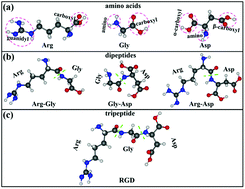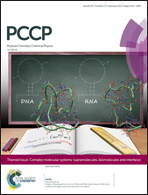A DFT study of the adsorption of short peptides on Mg and Mg-based alloy surfaces
Abstract
Adsorption of short peptides, including three dipeptides: arginine–glycine (Arg–Gly), glycine–aspartic acid (Gly–Asp), arginine–aspartic acid (Arg–Asp), and one tripeptide arginine–glycine–aspartic acid (RGD), on the surfaces of Mg and Mg alloys (Mg–Zn, Mg–Y, and Mg–Nd), was studied using the first-principles calculations based on density functional theory (DFT), considering van der Waals (vdW) correction. The calculated adsorption energies (Eads) of short peptides on the clean Mg(0001) surface are in the range of −1.73 to −2.80 eV per dipeptide, and −3.24 eV for RGD. The short peptides prefer to bond to Mg atoms at the surface by the O and N anions in their functional groups. For the clean Mg(0001) surface, the Eads of the short peptides are exclusively dominated by the number of functional groups binding to the surface. However, for the surface of the Mg–Zn alloy (1% Zn), the adsorption of the peptides is clearly enhanced (by about 0.3 eV per peptide) due to the enhanced N–Mg bond and the electrostatic interactions between the doped Zn at the surface and the backbone chains of the peptides. Furthermore, the attractive interactions are increased with the increase of doped Zn contents (up to 3%). In contrast, for the surfaces of Mg–Y (1% Y) and Mg–Nd (1% Nd) alloys, the adsorption of the peptides is slightly weakened compared to that on the clean Mg(0001) surfaces. Our results provide useful guidance in understanding the interactions between peptides and the Mg-based biomedical alloy surfaces at the atomic scale in the biomimetic coating fields.



 Please wait while we load your content...
Please wait while we load your content...